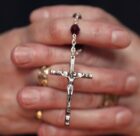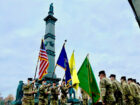Traditions can be broken, even at the Great Irish Fair.


Traditions can be broken, even at the Great Irish Fair.

What’s in a name? William Shakespeare asked that question in “Romeo and Juliet.” In Bay Ridge’s Irish American community, the answer is … plenty.

On March 6, the lower church at St. Patrick Parish hummed with a cacophony of reed instruments called “practice chanters” and a staccato of drum-sticks hitting practice pads, all to Celtic melodies and beats.

Claire Guernsey was eager to share her deeply held faith with the restless audience of Irish schoolkids. The students, however, didn’t share her enthusiasm. In fact, they were practically surly.

With a soundtrack of bagpipes and drums, marchers with banners and flags marched down 5th Avenue Thursday in the return of the annual St. Patrick’s Day Parade, a long-awaited rebound after a two-year pandemic-induced absence.

An iconic symbol of Irish Catholicism offers a sobering reminder about faith in New York City as well as on the Emerald Isle.

During his New Year message, Ireland’s primate expressed his “personal sense of sadness and loss” at the partition of Ireland.

On Dec. 13, 1862, a brigade of Union infantrymen, many of them Irish Catholic immigrants who had settled in Brooklyn and Queens, attacked a fortified Confederate position along the high ground south of Fredericksburg, Virginia. The so-called “Irish Brigade” comprised five regiments, three from New York City: the 63rd, 69th, and 88th.